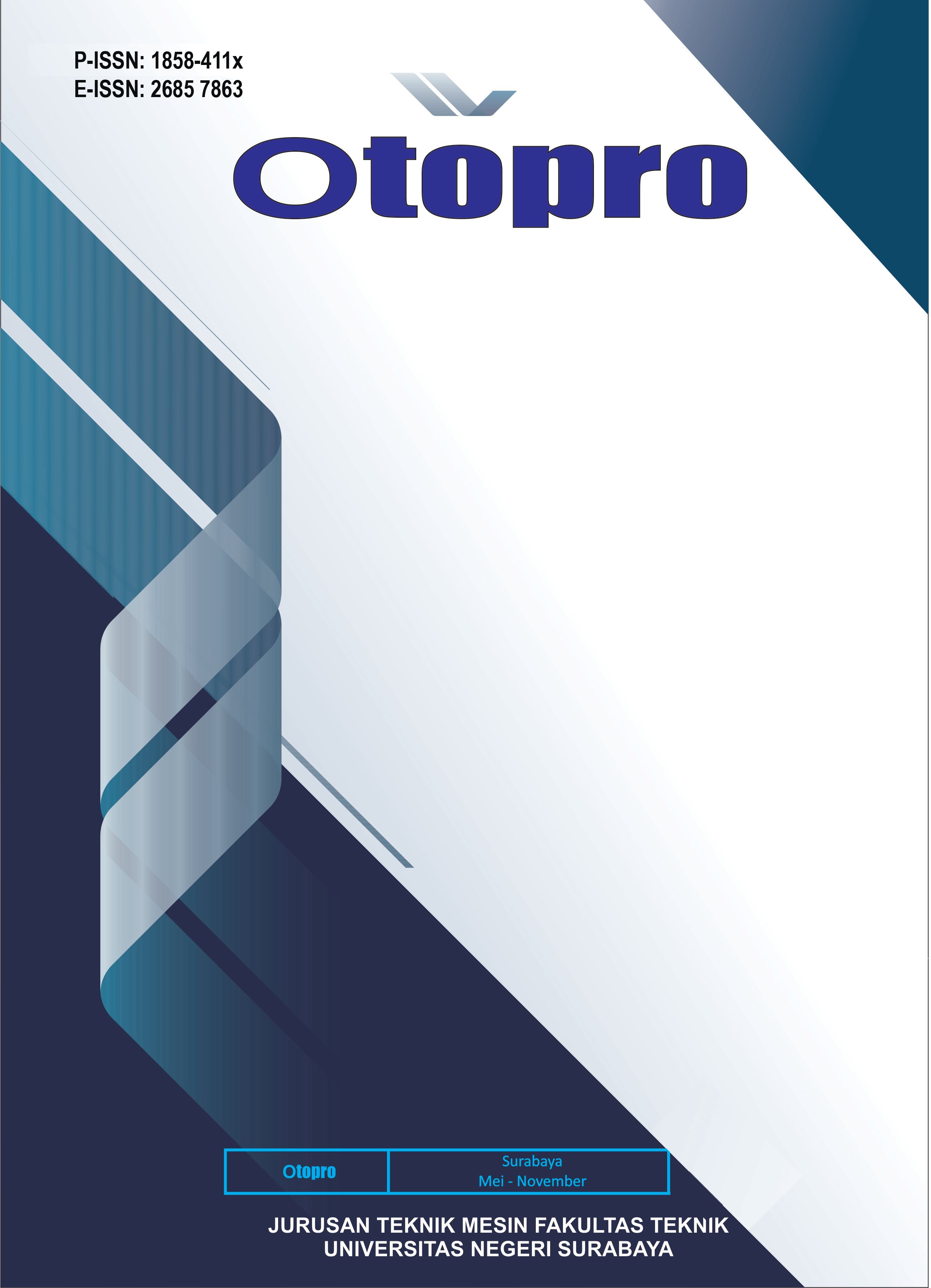PERANCANGAN CYLINDER CATCHPOT VACUUM INFUSION SEBAGAI MEDIA PEMBUAT KOMPOSIT SERAT KARBON
DOI:
https://doi.org/10.26740/otopro.v21n1.p30-37Abstract
The use of metal or steel in a variety of applications has begun to be replaced by Carbon Fiber Reinforced Polymer (CFRP). Some of the advantages of CFRP include mechanical strength almost equal to, and sometimes exceeding, that of metal materials. One innovation in the manufacture of carbon fibre composites is the vacuum infusion method. Resin is drawn into the mould under suction pressure from a vacuum pump. Excess resin is drained from the mould through a hose and collected in a container, which also serves to control the vacuum pressure in the mould before it enters the pump. Previously, the catchpot was made of square-shaped iron with permanently welded joints, resulting in unstable suction pressure. Additionally, the resin's fast curing properties made cleaning difficult, leading to blockages in the hose over time. These issues highlight the need for a vacuum infusion design that is easy to open and close, easy to control and leak-proof. In this study, a research and development (R&D) approach was taken. The design process for the Cylinder Catchpot Vacuum Infusion begins with the design, calculation, and design stages, and ends with functional testing. The design process takes into account dimensions and the motor power required to use ¼HP for a 1-liter catchpot. The component is manufactured through the manufacturing stage and undergoes functional testing, where the Cylinder Catchpot Vacuum Infusion tool detects no leaks in the circuit, ensuring stable pressure, and ensuring proper resin distribution throughout the fibers, ensuring no voids in the composite
References
D. S. Vijayan, A. Sivasuriyan, P. Devarajan, and E. Koda, “Carbon Fibre-Reinforced Polymer ( CFRP ) Composites in Civil,” 2023.
D. S. Pratama, R. S. Lubis, F. Setiawan, and E. Sofyan, “JOURNAL OF APPLIED MECHANICAL ENGINEERING AND RENEWABLE ENERGY ( JAMERE ) Uji Impact Material Komposit Campuran Serat Bambu Dan Pasir Besi Menggunakan Metode Hand Lay Up,” vol. 3, no. 1, pp. 28–33, 2023.
S. J. Ahmed, Q. Ahsan, M. Hasan, and M. Engineering, “ICME11-AM-017 DEVELOPMENT OF VACUUM ASSISTED RESIN INFUSION ( VARI ) MOLDING TECHNOLGY FOR THERMOSET BASED POLYMER MATRIX COMPOSITE WITH LOCALLY AVAILABLE RESOURCES,” vol. 2011, no. December, pp. 18–20, 2011.
R. D. Hidayatul, A. Syuhri, A. Z. Mutaqqin, and L. Rahmadhani, “PENGARUH POSISI VACUUM GATE TERHADAP MATERIAL TERBUANG,” vol. 4, pp. 82–85, 2017.
A. H. Fauziyyah, H. Poernomo, and G. Suhardjito, “Rancang bangun Dua Sistem untuk Vakum dan Kompresi dalam Satu Alat yang Digunakan untuk Vacuum Infusion pada Laminasi Kapal Fiber,” Conf. Des. Manuf. Eng. its Appl., no. 2654, pp. 87–90, 2018.
B. A. Salamun, “Perancangan dan Pembuatan Alat Vacuum Infusion”. 2017.
M. A. Mujakki, F. Y. Utama, and A. M. Sakti, “Rancang Bangun Vacuum Infusion dengan Flow Rate 84 L / min untuk Pembuatan Material Fiber Carbon Ringan,” vol. 08, no. 02, pp. 120–125, 2023.
S. W. E. Utomo, “Analisis Pengaruh Tekanan Vacuum Pada Proses Pembuatan Komposit Carbon Fiber Menggunakan Metode Vacuum Infusion,” Mach. J. Tek. Mesin, vol. 6, no. 2, pp. 6–11, 2020, doi: 10.33019/jm.v6i2.1438.
Sugiyono, Metode Penelitian Pendidikan (Pendekatan Kuantitatif, Kualitatif, dan R & D). Bandung: Alfabeta, 2013.

Downloads
Published
How to Cite
Issue
Section
License

This work is licensed under a Creative Commons Attribution-NonCommercial 4.0 International License.
 Abstract views: 49
,
Abstract views: 49
, PDF Downloads: 62
PDF Downloads: 62


3.png)










